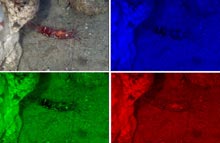
Yellow zooanthids on a glass sponge. Note that, though highly conspicuous under full light, they blend in with the sponge at blue wavelengths. Click image for larger view and image credit.
Virtual Oceanography
August 30, 2005
Sonke Johnsen, Ph.D.
Assistant Professor
Duke University
Latitude: 29° 18.750' N
Longitude: 94° 49.082' W
So what do you do at sea when you're not "at sea"? For the past five days we have been trapped in various ports, where the only signs of non-human life have been the snapping sounds of shrimp on our hull at night. Meals are long, naps are common, and cabin fever is rife.
So I've been doing something I almost never do at sea - analyzing my data. I usually avoid this because normally I am so busy collecting data. Also, for reasons we don't really understand, but seem to be due to wave action, most people are substantially dumber at sea. On my first cruises I would write down what I thought were great ideas, only to read them on land and then throw them away. So for me and most of us the mode is "collect now, think later". In port though, there's plenty of time and the mind still works.
The analysis I'm doing involves images of the deep-sea floor. Many animals at depth are colored. The colors usually range from yellow to red, but purples and other more exotic shades are also found. Some animals, especially the crabs, have complicated patterns on their bodies. On last year's cruise I found that, while the animals were very obvious under full-spectrum light, they actually blended into the background quite well when viewed under blue light. This was exciting to me, because the downwelling light at these depths is blue. So it appeared that all these crazy colors we'd see under the white lights of the sub were just by-products of pigments that were designed to hide the animal under the natural light.

Deep-sea shrimp. Upper left hand panel shows full color image. The other three panels show how the shrimp appears under blue, green, and red light. Click image for larger view and image credit.
The analysis I did last year was of video taken at a depth of 1000 feet. At this depth, it is still relatively bright, about the same as late twilight. This year I wanted to find out what happened at deeper depths, where it was much darker. My original plan was to put color filters in front of the camera. When this turned out to be impossible because there just wasn't enough room inside the pressure housing for the filter, I thought of putting filters on the submersible's lights. Finally it looked like the best method was to use the filters that are inside the video camera itself. Every color video camera has tiny interlaced filters. These are red, blue, and green and make the sensors underneath them sensitive to only those colors. Using these filters, I could take the exact same picture in red, green, and blue light. This would have been much more difficult with large filters on the lights themselves. I could also use the videos taken during all the dives, not just my own.
The actual process involves watching each video and then "capturing" good images using video analysis software. This is a fun process, because I get to re-live each dive on the cruise. The captured images are next split into their three color channels using another image analysis program. I then scale the brightnesses to account for the fact that the submersible's lights are brighter at some colors than at others.
This process, repeated for about 100 images, has taken me to this point. Now I have been talking with my colleagues about the best way to determine how well-hidden the animals are when viewed under different colors. One possibility is to use humans to rank the camouflage, creating a survey that many people would take. Another involves measuring the brightness of the animals and comparing it to the brightness of the backgrounds. These are things that I usually think about on land, but it's been wonderful to discuss it with my colleagues who are usually scattered all over the globe.
From my first look at these images though, it appears that animals at this greater depth (~2000 feet), aren't camouflaged nearly as well as those at shallower depths. This is exciting to me for two reasons. First, it means camouflage may not be important at these depths. Second, if this is true, then what are these colors for? The best results for me are always those that bring up new questions.
I love being at sea. I love the movement of the boat, the color of the water, the amazing sky during the day and the stars at night. Being stuck in port is just not the same. But sitting at the computers watching these dives lets me pretend.
Addendum, written later the same day:
I read what I've written, and it seems a small thing when weighed against the destruction of the past two days. How can I, or anyone else, justify going down in submersibles when thousands of people have just lost their homes? Does scientific research save the environment? Does it help people? Sometimes. Often much later and in unanticipated ways.
At the moment, all I can offer is this. Our living world may be the most remarkable thing ever created. Its complexity and beauty are overwhelming - an ultimate symphony. And we may be the only ones capable of listening and understanding. I study nature and tell people about it because I can't help it. It is both a wonderful thing to me and a duty. Is it enough? I honestly don't know.


























